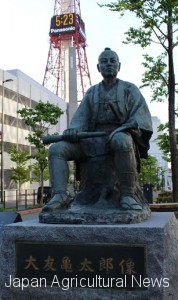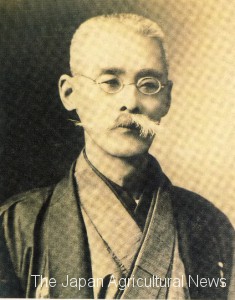Management by spirit of mutual aid and Hotoku thought
There is a history of the development in Hokkaido prefecture. Sontoku Ninomiya( 1787 ~ 1856 ), who had worked on wasteland reclamation in the Kanto and Tohoku, was ordered to help the development there. Hakodate magistrate asked Sontoku for development of Ezo region (current Hokkaido) in 1855 (Ansei 2).
At that time Sontoku was not health. He wrote the letter of refuse with reason that “I can not assume the responsibility, and my son (Sonko)is also half a man.”
Immediately Hakodate magistrate sent letter to order “to write the name of candidate able to develop in new place.” He answered, “there is no disciples fully able to work away from my hand.” Temporary, exchange was interrupted. On October 20, 1856 (Ansei 3), Sontoku was dead at the age of 70.
At the time, Russian warships came southward, so that Russian ambition of Sakhalin occupation had become obvious. In Ansei 4 (1857), the request of Ezo development came to Soma-Nakamura clan (Fukushima Prefecture) where there were disciples of Sontoku. Two Samurai went to Hokkaido and Kametaro Otomo ( 1834 ~ 1897 ), born in Odawara and disciple of Sontoku and Sonko, was also accompanied as a servant. Kametaro’s house was located on the opposite shore of Kayama village (Kayama, Odawara city), where Sontoku grew up, across the Sakawa river.
Kametaro, in order to promote the settlement of farmers, ensured the drinking water and developed traffic passage, the bridge, and the canal. It was the rush job of using the daily 40 ~ 50 workers including people recruited from Ishikari region.
Canal that took advantage of the natural inclination was called “Moat of Otomo”. Currently it became “Sosei River” penetrating to the north and south of the center of Sapporo city, and is familiar to citizens. Kametaro is said to be the founder of Sapporo city.
Kametaro is extremely strict in the implementation of development projects, but he had rich humanity so that farmers were attracted to him. He planted the spirit of ” shisei (sincerity)” and Hotoku thought, and after stay for 5 years, he left Sapporo city in Meiji 3 (1970), due to her mother’s illness.
Independence support to subsistence farmers
Around this time, Kokei Tomita ( 1814 ~ 1890 ) and Takayuki Saito ( 1819 ~ 1894 ) , two of the four major disciples of Sontoku, had led the refinancing Soma-Nakamura clan with Takachika( 1855 ~ 1922 ), Sontoku’s grandson. After abolition of clans and establishment of prefectures, Tomita and Takachika asked continuation of funding support to the national government and Fukushima prefecture but such petition was refused.
So, in Meiji 10 (1877), they founded “Kofuku-sha” aiming for rural reconstruction. The company started with president Tomita and vice president Saito, but immediately Takachika became vice president, and after death of Tomita, Takachika became president.
At the time, Hokkaido was taking immigration policy. Takachika decided to emigrate to Hokkaido. He dispatched the expedition which he became the leader. He decided to settlement to Ushishubetsu wilderness (Toyokoro Moiwa district), which was introduced by young Ainu people. In Ainu language, “Ushishubetsu” means “a lot of footprints of deer river”.
The first batch, which was composed of 19 units, was settled until April Meiji 30 (1897). After arrival, he started a communal life in the indigenous hut. They cultivated their own distributed lands. Roads were muddy and impassable. According to record, they could not bathe for few tens of days, and they ate ” potatoes, as the staple food.”
He was emulating Shiho program of grandfather-Sontoku regarding organizational operation. He made villagers to vote in secret ballot well working person and person who made good things, and elected 3 persons who got the highest points. And he gave elected persons prize money in basis of 0.25-yen per1 vote, and also gave them hanging scroll of Hotoku thought and farm equipment as extra prize. To this place, about 160 units emigrated in total for 10 years.
Takaaki Oodawara, Honorary professor of Hokkaido University, said “in the Hokkaido, there was no village community. Therefore, farmers needed considerable training for independence as subsistence farmers. Teachings of Sontoku (kinben, bundo, suijo), and the spirit of mutual aid led to the success of the development. ”
Mental cornerstone
Settlers of Meiji period, especially organizations immigrants were in need of a mental foothold. Takachika Ninomiya of Kofuku-sha became its center. In the development of the Tokachi region, Benzo Yoda, who was born in Shizuoka prefecture and strongly influenced by Hotoku thought, settled in Obihiro region, in Meiji 16 (1883). Yoda often visited Takachika in Toyokoro and piled up friendship. Kansai Seki, the founder of Tokachi Rikubetsu region and Sekizen-sha, was also a believer in Hotoku thought and deepened friendship with Takachika.
Not just Tokachi region. Other central Hokkaido settlers, such as Magozaemon Sekiya in Nopporo region, Seitaro Yamada and Eizaburo Honda in Kurisawa region, Naoshiro Tsujimura in Iwamizawa region, also emulated the management of Hotoku Shiho.
The influence of Hotoku thought was greater in the development phase. It is clear from the fact that there are many names of “Hotoku” and “Ninomiya” of the village name in the region.



